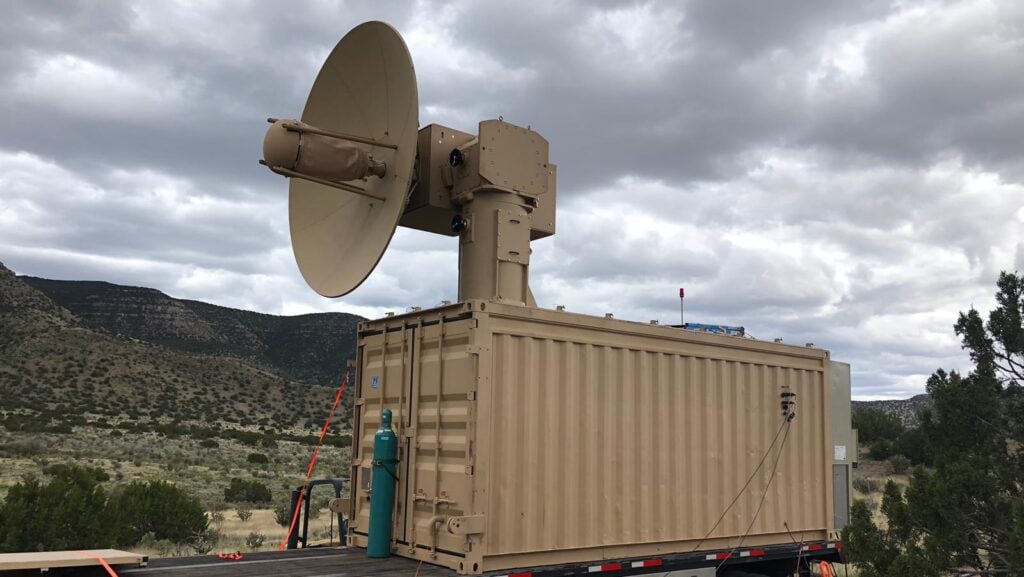
WASHINGTON — Low-cost drones and cheap cruise missiles keep slipping under the radar of air defense systems worldwide, from the Red Sea to Ukraine, or overwhelm defenders by just being too numerous to stop with limited supplies of expensive anti-aircraft missiles. So, argue advocates of directed energy weapons, shouldn’t the US rush to field large numbers of high-energy lasers and high-powered microwaves, that can keep firing shots at the literal speed of light as long as they have electrical power?
The potential is huge and the technology’s maturing impressively, agreed officials from both the R&D and acquisition & sustainment sides of the Pentagon, speaking Tuesday at the rollout of a National Defense Industrial Association report on the still-nascent supply chain for the weapons. But, Frank Peterkin, principal director for directed energy research, and Chris Behre, principal engineer for directed energy (DE) acquisition, warned the NDIA audience, the devil is still in the details of how to use directed energy in combat.
Those unanswered questions range from how to integrate lasers alongside traditional missile- and gun-based air defense, to how to restructure command-and-control networks, supply lines, weapons testing infrastructure and, above all, training. Until the military has a better grasp on all those issues, Peterkin and Behre told NDIA, it needs to keep experimenting and field-testing with small numbers of different systems. That means the ramp-up industry has asked for is still some years away.
RELATED: ‘It’s hard’: Navy needs to be realistic about laser weapons, admiral says
Now, there has been real progress already, from the Reagan administration’s abandoned “Star Wars” vision of the 1980s and the Airborne Laser cancelled in the 2010s — a Boeing 747 filled with toxic chemicals to generate the requisite power — to the more efficient solid-state lasers and drone-frying microwaves in exploratory use today.
“In the last 10 years, we went from one laser that the Navy had employed … to the many double digits today,” said Peterkin. “That’s a real sea change.”
“But realistically, in the Department of Defense, you can build all the shiny widgets you want and you’re not going to transition [to production] unless you address some other issues, like how would the operator use your system,” Peterkin continued. “We’re getting after that today through prototypes and operational experimentation. … Nobody is going to believe us in the near term when we say, ‘Trust us, we ran a model and the directed energy system is going to work.'”
RELATED: Laser weapons ‘finally’ seeing ‘real progress,’ Missile Defense Agency official says
That requires extensive testing in realistic conditions, both in the US and on limited deployments, of a wide variety of different systems — but at this stage the military needs only a handful of each.
“I sat down this morning with a pad of paper and tallied about 30 different DE programs … that have come together in the last 10 years,” said Behre. “Two dozen of those have been put in the hands of the warfighter where we gained valuable feedback.”
“Over the last five years, we’ve also seen a trend of both industry IRAD [independent research and development] and government procurements, working not in onesie-twosies like we were in the past, but in procuring two, three, four, five systems at a time,” Behre told the NDIA audience.
But even that limited ramp-up has been challenging. “That’s been a real test of our supply chain,” he said. “We see that result in extended lead times and difficulties in meeting schedules.”
So how does the Pentagon fix that supply chain problem? That’s the topic of the new NDIA report.

Mirror, Mirror, In The Industrial Base
Written by the NDIA’s in-house thinktank, the Emerging Technologies Institute, the new report laments multiple weak points in the supply chain for laser and microwave weapons, from exotic rare earth elements imported from China to esoteric techniques for polishing and coating laser-reflective mirrors.
“While the overall financial health of directed energy companies is relatively stable, the failure of even a single company could have severe repercussions due to limited supplier concerns,” the report warns. “Limited suppliers exist throughout DEW [Directed Energy Weapon] supply chains but especially in beam directors, adaptive optics, optical coatings, specialty optical fiber, beam dumps, ceramic laser materials, and fused silica.”
The report also proposes half a dozen fixes, from stockpiling gallium (also used for radars), to setting up a public-private consortium to train specialized workers, to collaborating with allies like Australia and Israel. But the theme that comes up over and over is the Pentagon just needs to buy more.
“The U.S. Department of Defense (DoD) has often wavered in its commitment to fielding DEWs at scale,” the NDIA report says. “Without a clear and sustained demand signal from DoD, and therefore a return on investment, industry is hesitant to make the investments necessary to have secure, healthy, and resilient DEW supply chains. … The most important step DoD can take to secure directed energy weapon supply chains for the future is to provide a consistent demand signal to industry. … Once DoD’s strategic goals are articulated, appropriate DEW systems should be transitioned to programs of record and multi-year contracts used to send an extended demand signal.”
The report does acknowledge potential synergies and cost savings from commercial industry, but there’s a limit to those. While lasers and microwaves are widely used in civilian life, with a robust supply chain, military models face extreme challenges that require unique components built in specialized facilities. A car-maker’s industrial steel-cutting laser, for instance, doesn’t have to hold its focus on a rapidly moving target hundreds of yards or even tens of miles away. A kitchen microwave just has to boil your tea, not fry the circuits of an attacking drone. That means the military is the only customer for some of the most complex tech.
But precisely because that tech is so complex, the military is still figuring it out. The challenge is not just the machinery itself but how to deploy and employ it in real-world operations.
No one’s proposing to just build a bunch of laser guns, give them to soldiers and start blasting. Still too big for individual soldiers and too weak to destroy armored vehicles, lasers and microwave weapons are being sought after specifically to shoot down incoming drones and, potentially in the further future, more difficult aerial threats like subsonic cruise missiles and even supersonic or hypersonic targets. But those missions require not just one type of weapon but an integrated air and missile defense system. That means a wide-area communications network linking early warning radars, more focused targeting radars, command posts and multiple types of weapons for multiple types of targets and different conditions.
Lasers, for instance, don’t work as well when the beam must pass through rain or smoke, as experts noted during the NDIA rollout event. That means commanders may have to rely more on old-school missiles and guns in certain weather conditions. But which conditions require what kind of technical and tactical adjustments is a tricky question to work out, let alone encode in field manuals and command-and-control software.
On the flipside, a laser beam fired into a clear blue may keep going at a dangerous level of power for a long, long way. That fact of physics has scared the FAA into restricting testing of the weapons in US airspace. So, as with hypersonic missile tech, simply finding test facilities and getting enough time on them has been a stumbling block for directed energy programs.
That’s one more reason among many why fielding laser and microwave weapons is going to take some time — which is little consolation to the people who build them.
“Hats off to the to the companies and the organizations that are hanging in there while we decided at the DoD level when we’re going to actually procure these in numbers,” Peterkin told the industry audience. “We need that industrial base to be healthy. We need that supply chain to be healthy.”

